no sea lions left on North rocks due to large swells. Eight mature bald eagles on South East rocks. For immature old Eagles on West rocks. 26 black oystercatcher’s on South shore of great race. Over 20 black Turnstons and 2230 starlings as well.
Temperature rise
temperature rise today is reflected in the return of the seagulls and 150 cormorants +60 starlings, 25 black Turnstons, 15 black oyster catchers, 16 crows, 21 bald eagles [10 mature
5 sealions hauled out on North rock. 120 sealions on West race. 22 on great race .
143/32 second nature was out with BCTEL learning Channel promo visit. Angus, Garry, and Chris with them.
BCTEL takes a trip with Pearson College to Race Rocks
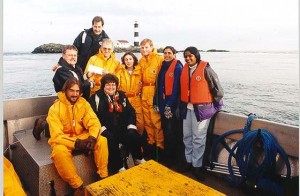 On January 13, 1998, BCTEL** (Discovery Learning) representatives took a trip to Race Rocks Ecological Reserve with Pearson College faculty member Garry Fletcher and some of his students. They had invited them to see first hand many of the Pearson College marine science educational projects that are highlighted on the College’s web page. BCTEL (Discovery Learning) provides the College with internet support, making this unique marine science project globally accessible. Following the Race Rocks visit, BCTEL presented the students with a $5,000 cash gift for the College’s annual fund.
On January 13, 1998, BCTEL** (Discovery Learning) representatives took a trip to Race Rocks Ecological Reserve with Pearson College faculty member Garry Fletcher and some of his students. They had invited them to see first hand many of the Pearson College marine science educational projects that are highlighted on the College’s web page. BCTEL (Discovery Learning) provides the College with internet support, making this unique marine science project globally accessible. Following the Race Rocks visit, BCTEL presented the students with a $5,000 cash gift for the College’s annual fund.
**now Telus
cold, -3°C
a few gulls and only 2 Eagles in the area, very cold -3° C with Northeast winds 22 to 35.
15 20 Sea lions are called out on the S. side.
300 sea lions are rafting on the south and west side of great race.
At 1510 Snow has started, northeast 24, visibility 1/2 mile. Ground white in 10 minutes .
Helicopter in
10 o’clock number 304 Coast Guard helicopter in with two men from Victoria base to pour cement pad for fuel hose reels. Returned at 1400 hrs. to pick up crew. 100 sea lions , 60% Steller’s, cold North East outflow winds all day.
Three bald eagles, two mature here most of the day.
Moulting Elephant Seal
Angus over from the college testing the new cell phone that has been installed. At 1150 and elephant seal has hold out in East Bay, 50 feet from the water. It seems to be in moult many sores on the body, shivering although out of the wind. W
MEASUREMENT OF SURFACE AREA USING “NIH IMAGE”
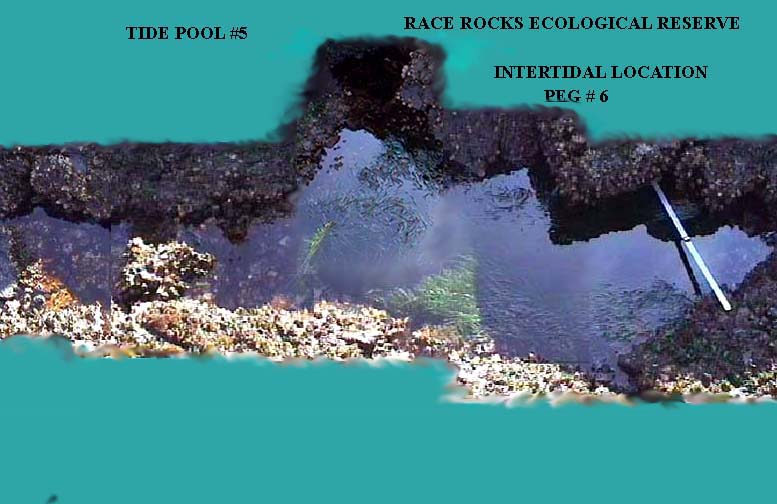 The image that you have available must be either a .Tiff or a .Pict . You may download the full screen version of this image, pool5.jpg and then convert it to one of those formats using graphics converter or Photoshop or any suitable image handling program.The image of the tide pool shown here has a 1 meter ruler in it . An object of known length must be present in the picture in order to do measurements.
The image that you have available must be either a .Tiff or a .Pict . You may download the full screen version of this image, pool5.jpg and then convert it to one of those formats using graphics converter or Photoshop or any suitable image handling program.The image of the tide pool shown here has a 1 meter ruler in it . An object of known length must be present in the picture in order to do measurements.
1. Open NIH image using the small black microscope icon. (If you do not have NIH Image installed on your computer you may download it here. download NIH Image ( available in Mac or PC )
2. Open the image “pool5.pict” that you have made by downloading the “pool5.jpg”.
3. From the TOOLS pop-up menu in NIH Image, select the SELECT LINES tool ( the dotted line fifth from the top of the right hand column).
4. Click and drag the select lines tool over the one meter image in the picture.
5. Click on the top Menu bar item ANALYZE, then move down to SET SCALE
6. In the SET SCALE box, set the units to centimeters. Set the KNOWN DISTANCE to 100., press “OK“
7. Select the region to measure using the freehand selection tool, ( fourth down on the Tools bar– heart shaped dotted line.)
8. Outline the area to be measured by tracing the perimeter of it with this tool.
9. CLICK on ANALYZE– OPTIONS – in the tool bar.
10 .Click in the boxes for Perimeter and Area. ( Other options may be tried after this basic step has been mastered.)
11. Click on ANALYZE — MEASURE –ANALYZE–SHOW RESULTS . Now you should see the calculated area and perimeter in the results box.
Further information on page 6 of the “NIH Image” direction manual
snow on mainland
Jan 4 cold-weather, snow on mainland but not on racerocks.—- January, 5- over 300 gulls on the east shore , no bald eagles today.
starlings
at 1405 Spring Tide tour boat came through the reserve. There are a large group of gulls, and cormorants, as well as a flock of 60+ European starlings around the reserve today. The 16 oyster catchers are still in the East Bay area. Three elephant seals are hauled out on the South Shore by the engine room for some part of each day.
Contemporary History of the Race Rocks Light station 1974-1997
The Demolition Phase :
|
| Trev and Flo had unusual retirement plans. They constructed a magnificent forty-four foot ketch right on the shore at Race Rocks. During seven years of construction, Trev had the fledgling hull secured by heavy cables to eyes driven into the rocks to prevent a shipwreck from the winter North East storms before she was even launched. While she was under construction the sailboats ribs looked more like a beached whale. |
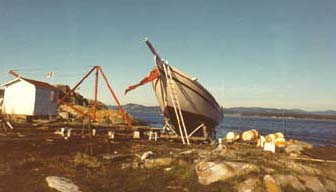 On February 7, 1982 Wawa the Wayward Goose was launched and the Andersons set off on a two year voyage that took them north to the Queen Charlottes and across the Pacific to New Zealand and back aboard their Race Rocks built sailboat.
On February 7, 1982 Wawa the Wayward Goose was launched and the Andersons set off on a two year voyage that took them north to the Queen Charlottes and across the Pacific to New Zealand and back aboard their Race Rocks built sailboat.
 Lester B. Pearson College was established in nearby Pedder Bay in 1974. Students from around the world came to study at the College which was named in memory of the former Canadian Prime Minister and Nobel Prize winner. The College was established to promote international understanding. All students attended Pearson College on full scholarship and came from everywhere; from Papua New Guinea to Poland. It wasn’t long until the students started to visit Race Rocks as Pearson College operated a much needed rescue service in the area. Faculty and students in marine biology classes and in the Diving Service began to study the extraordinary marine life at Race Rocks. It became clear that the fast flowing, nutrient rich waters supported large, diverse populations of marine life. After over a century of protecting others, Race Rock was in fact in need of protection itself. From 1978 on, they urged the faculty and students to seek formal protection for the natural environment and the rich biodiversity of the area. In 1980, after Pearson College students and faculty worked with the Ecological Reserves office of the (then) Department of Lands, Parks and Housing, the Race Rocks Ecological Reserve was established by an order in Council of the Cabinet of the Provincial Government in British Columbia. In the few years preceding this, the Andersons had assisted the students in every way they could and kept a watchful eye over the area.
Lester B. Pearson College was established in nearby Pedder Bay in 1974. Students from around the world came to study at the College which was named in memory of the former Canadian Prime Minister and Nobel Prize winner. The College was established to promote international understanding. All students attended Pearson College on full scholarship and came from everywhere; from Papua New Guinea to Poland. It wasn’t long until the students started to visit Race Rocks as Pearson College operated a much needed rescue service in the area. Faculty and students in marine biology classes and in the Diving Service began to study the extraordinary marine life at Race Rocks. It became clear that the fast flowing, nutrient rich waters supported large, diverse populations of marine life. After over a century of protecting others, Race Rock was in fact in need of protection itself. From 1978 on, they urged the faculty and students to seek formal protection for the natural environment and the rich biodiversity of the area. In 1980, after Pearson College students and faculty worked with the Ecological Reserves office of the (then) Department of Lands, Parks and Housing, the Race Rocks Ecological Reserve was established by an order in Council of the Cabinet of the Provincial Government in British Columbia. In the few years preceding this, the Andersons had assisted the students in every way they could and kept a watchful eye over the area.
( Go to this file for a more detailed history of the establishment of the Ecological Reserve.)
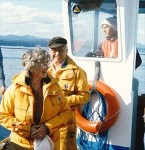 After a short interval after the departure of the Anderson’s in 1982, when the station was covered by relief keepers, the Redheads took over at Race Rocks. They served more than the station during their tenure; they served muffins! Several generations of Pearson College students the world over still remember hot chocolate and muffins in their kitchen, after a cold scuba dive. Charles and Joan Redhead continued the strong interest in protecting the ecology of Race Rocks. For a few years before retirement, they shared the island with the assistant lightkeepers Warren and Elaine Kennedy. All four keepers often turned out to greet the students as they came ashore. See updates in the file on these four lightkeepers
After a short interval after the departure of the Anderson’s in 1982, when the station was covered by relief keepers, the Redheads took over at Race Rocks. They served more than the station during their tenure; they served muffins! Several generations of Pearson College students the world over still remember hot chocolate and muffins in their kitchen, after a cold scuba dive. Charles and Joan Redhead continued the strong interest in protecting the ecology of Race Rocks. For a few years before retirement, they shared the island with the assistant lightkeepers Warren and Elaine Kennedy. All four keepers often turned out to greet the students as they came ashore. See updates in the file on these four lightkeepers
- MIKE AND CAROL SLATER-The last lightkeepers of Race Rocks 1990-1997In 1990 the head keeper Mike Slater and his wife Carol came to the station. Carol in particular held strong views about the need to live in harmony with the nature that truly surrounds Race Rocks. The Slaters worked hard to protect the reserve and assist researchers. These volunteer activities fall far outside their regular lightstation duties. During the early 1990’s the ominous signs of the first radical change at Race Rocks became apparent as the Coast Guard experimented with automated equipment to operate the station.
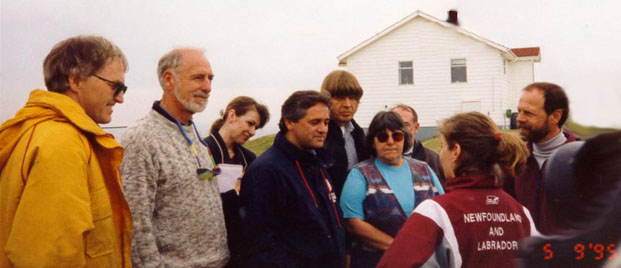 In the spring of 1994 the first announcements about de-staffing of lightstations on the British Columbia Coast were made. The decision was surprising and unpopular. In September, 1995, the Minister of Fisheries, Brian Tobin and the MP for Victoria and Environment Minster David Anderson paid a visit to the island and are shown here talking with Mike and Carol Slater and Garry Fletcher and Mike Hobbis, and Pearson students. Most surprising, a few months later was the announcement that Race Rocks was on the list of the seven stations to be de-staffed in the first round of budget cuts. Race Rocks was to be closed on March 1st 1997. Mike and Carol watched as the last of the automated equipment was installed and a maintenance crew measured the windows of their house for shutters. They might as well have measured the keepers for a box too as the end of a way of life would be coming to Race Rocks.
In the spring of 1994 the first announcements about de-staffing of lightstations on the British Columbia Coast were made. The decision was surprising and unpopular. In September, 1995, the Minister of Fisheries, Brian Tobin and the MP for Victoria and Environment Minster David Anderson paid a visit to the island and are shown here talking with Mike and Carol Slater and Garry Fletcher and Mike Hobbis, and Pearson students. Most surprising, a few months later was the announcement that Race Rocks was on the list of the seven stations to be de-staffed in the first round of budget cuts. Race Rocks was to be closed on March 1st 1997. Mike and Carol watched as the last of the automated equipment was installed and a maintenance crew measured the windows of their house for shutters. They might as well have measured the keepers for a box too as the end of a way of life would be coming to Race Rocks.
For the time being Race Rocks and its keepers won a reprieve. In an emergency two year agreement Pearson College undertook to operate the facility in cooperation with the Coast Guard, as an education centre. A private donor agreed to cover the salary costs for the Slaters who were invited to stay on at Race Rocks by Pearson College. The College continued negotiations with the Provincial Government, the actual owners of the land, to operate the facility on a long term basis. Seventeen years later, Lester B. Pearson College is still managing the island on a long term lease from BC Parks.
They have to raise the funding and manage all utilities and repairs on the island without government help and are determined to make the island self-sufficient. With that in mind, the Race Rocks endowment fund has been set up for operating racerocks.
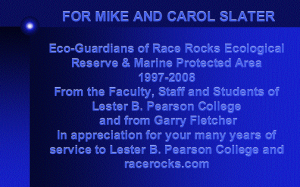 In December of 2008, Mike and Carol Slater retired from Race Rocks where they had been employed by Lester Pearson College as the Ecological Reserve and MPA Guardians since 1997. This Powerpoint presentation touches on some of the aspects of their life in the last few years at Race Rocks.
In December of 2008, Mike and Carol Slater retired from Race Rocks where they had been employed by Lester Pearson College as the Ecological Reserve and MPA Guardians since 1997. This Powerpoint presentation touches on some of the aspects of their life in the last few years at Race Rocks.
- During the following years, from 1997 to 2000, The Canadian Coast Guard and the Provincial Parks Department started the process of transferring the property, upgrading essential parts and restoring some of the areas used by the Coastguard back to a natural ecosystem.
- In 2001, Great Race Rocks was added to the Ecological reserve.
- In September of 1998, The Minister of Oceans and Fisheries, the Honourable David Anderson, announced the proposal to make the Ecological reserve and all the Islands of Race Rocks into a Pilot Marine Protected Area (pilot MPA) for eventual designation as a Marine Protected Area ( MPA) under the Ocean’s Act. This index contains the information on that prolonged process.
- In recognition of the FirstNations role in Race Rocks, A process of involving the Coast Salish people in the educational program for the Race Rocks MPA was started. .The Race Rocks Advisory Board with First Nations representation was set up in the fall of 1999 to further the creation of the MPA.
- See this file for information on Administration of the Islands
I wish to acknowledge the assistance of the British Columbia Archives in making the photos from the early years on Race Rocks available to us, and Trev and Flo Anderson, and Joan Redhead for the more recent pictures.

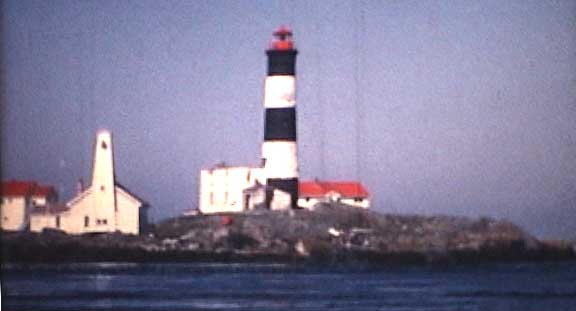 The demolition by the Canadian Coast Guard of some of the historic structures on the island in the 1960’s and 1970’s
The demolition by the Canadian Coast Guard of some of the historic structures on the island in the 1960’s and 1970’s